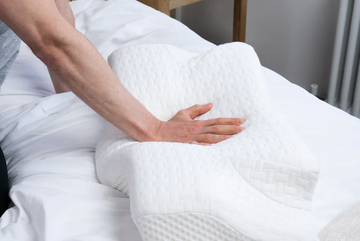What Is a Cervical Pillow?
Why Use Memory Foam for a Cervical Pillow?
Memory foam, or slow rebound foam, is a polyurethane material with an open-cell structure, known for its viscoelastic properties. It was first developed by NASA in 1962 to improve comfort and protection in spacecraft seats. Today, it's widely used in products like pillows due to its unique qualities.
- Temperature Sensitivity:
Memory foam responds to your body heat, softening to mold perfectly to your head and neck, while firmer areas provide consistent support where you need it most. - Viscoelastic Properties:
Memory foam slowly compresses under pressure and returns to its original shape, which is why it’s often called "zero pressure foam." It evenly distributes weight, reducing pressure points and giving you a floating sensation.
How to choose the best cervical memory foam pillow for neck and shoulder pain?
By Materials
Memory foam density impacts both support and cost—higher density means better support and durability, but also a higher price. For solid body support, look for a density of at least 80D, with 120D being top-tier for slow-rebound properties. Since quality varies, it's wise to choose established brands with proper certifications.


By Sleeping Position
According to James Leinhart, the best pillow should give you a sense of where your body is, helping you feel comfortable as you sleep. A good rule of thumb is that your pillow should fill the space between your ear and shoulder, providing support without sinking too much, so you don’t strain your muscles.
How to Properly Use a Cervical Pillow?

For back sleepers
The pillow should support the natural curve of your neck, with the flatter side under your head and the raised side under your neck.

For side sleepers
The pillow should fill the space between your neck and the mattress, keeping your head aligned with your spine.
The Benefits of Cervical Pillows Beyond Neck Pain Relief
Cervical pillows are designed to promote proper spinal alignment during sleep, which can lead to improved comfort and potentially better sleep quality. By supporting the natural curvature of the neck, these pillows may also reduce tension in the shoulders and back. While some users report benefits such as reduced snoring or headaches, these effects can vary and should not be considered guaranteed outcomes.
Frequently Asked Questions About Cervical Pillows
Cervical Memory Foam Pillow How To Use
Who should use a cervical pillow?
Anyone looking to maintain proper neck and spine alignment during sleep, especially those who wake up with neck discomfort or prefer sleeping on their back or side.
How long to adjust to a cervical pillow?
It typically takes a few days to a few weeks to get used to a cervical pillow, as your body adjusts to the new support.
How often should you replace a cervical pillow?
It’s recommended to replace your cervical pillow every 18 to 24 months, depending on the material and usage, as it may lose shape and support over time.
Can cervical pillows reduce snoring?
Cervical pillows can help keep the airway open by improving neck and head alignment, which might reduce snoring for some, depending on the underlying cause.
Are cervical pillows suitable for all ages?
Cervical pillows are mainly recommended for adults because they support the mature neck and spine. For children, it's important to be cautious due to their developing spine. It's best to consult a healthcare professional before using a cervical pillow for anyone under 12.


